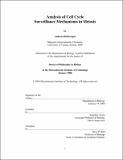Analysis of cell cycle surveillance mechanisms in meiosis
Author(s)
Hochwagen, Andreas
DownloadFull printable version (7.015Mb)
Other Contributors
Massachusetts Institute of Technology. Dept. of Biology.
Advisor
Angelika Amon.
Terms of use
Metadata
Show full item recordAbstract
Numerous DNA double-strand breaks (DSBs) are introduced into the genome in the course of meiotic recombination. This poses a significant hazard to the genomic integrity of the cell. Studies in a number of organisms have unveiled the existence of surveillance mechanisms or checkpoints that couple DNA repair and microtubule integrity to meiotic cell cycle progression. Through their action, aberrant meiocytes are delayed in their meiotic progression to facilitate repair of meiotic DSBs, or are culled through programmed cell death, thereby protecting the germline from aneuploidies that could lead to spontaneous abortions, birth defects and cancer predisposition in the offspring. Two such surveillance mechanisms are analyzed in this thesis. The first is the meiotic recombination checkpoint, which delays meiotic cells in G2/prophase if recombination intermediates remain unrepaired. The extent of the delay is modulated by protein phosphatase 1 (PP1), whose activity allows cells to overcome the checkpoint dependent delay in a process called adaptation. In this work, experiments in the budding yeast Saccharomyces cerevisiae are described that show that premature adaptation is prevented by the FK506-binding protein Fpr3, which associates with and counteracts PP1 in vivo. (cont.) The checkpoint activity of Fpr3 can be inhibited by the small molecule inhibitor rapamycin and requires the proline isomerase domain of Fpr3, but not its catalytic activity. The second surveillance mechanism analyzed here is a spindle checkpoint independent arrest response of meiotic cells to microtubule perturbation. This arrest is caused by down-regulation of the meiotic transcriptional program and occurs at one of two possible stages, in meiotic G1 prior to entry into the meiotic program, or in meiotic G2/prophase after pre-meiotic DNA replication. Both mechanisms described in this work may be conserved in other organisms, including mammals. The findings presented herein are incorporated into a general model of the surveillance mechanisms of meiotic recombination.
Description
Thesis (Ph. D.)--Massachusetts Institute of Technology, Dept. of Biology, 2006. This electronic version was submitted by the student author. The certified thesis is available in the Institute Archives and Special Collections. Vita. Includes bibliographical references.
Date issued
2006Department
Massachusetts Institute of Technology. Department of BiologyPublisher
Massachusetts Institute of Technology
Keywords
Biology.